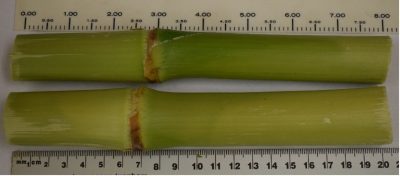By Haiying Tao, Ph.D., UConn Home & Garden Education Center
Nitrogen (N) is often the most limiting nutrient in growing plants. When deficient, plant yields and quality are reduced. However, excessive nitrogen applications could cause concerns in water quality and greenhouse gas emissions. Managing nitrogen is a very difficult task for farmers and gardeners because nitrogen exists in many different forms in the soil and can be lost from soil via many pathways. In addition, different forms nitrogen can be transformed from one form to another. The weather, especially rainfall and temperature, can impact these processes. Heavy rainfall can lead to significant nitrogen leaching and runoff.
Fortunately, there are strategies that can be used to help us manage nitrogen for optimum plant yield and quality, while minimizing nitrogen loss. Most home gardeners benefit from the standard nutrient analysis when testing their soil. Recommendations and questions regarding additional sampling, interpretation, and fertilization recommendations for specific tests and crops mentioned below should be referred to the University of Connecticut Soil Nutrient Analysis Laboratory.
Predict nitrogen requirement and preplant soil tests
Testing soil for nitrate and ammonium forms of nitrogen as well as soil organic matter (SOM) can help you predict soil nitrogen supply during the growing season. SOM can provide substantial amounts of nitrogen via mineralization, which is a process where soil microorganisms convert organic forms of nitrogen to the plant available forms of ammonium and nitrates.
Typically, for every 1% of SOM in the top 6 inches of soil, approximately 20 to 40 lbs of nitrogen per acre can become available via the mineralization process. If you can predict the nitrogen requirement of the desired crop, the amount of nitrogen that needs to be applied can then be estimated using the differences between demand and supply. Note that for SOM testing, 6-inch soil sampling depth is typically recommended.
Pre-sidedress Soil Nitrogen Test (PSNT)
The Pre-sidedress soil nitrate-nitrogen test (PSNT) can be used for corn and vegetable crops such as tomatoes, peppers, fall planted cabbage, etc. Soil sampling and testing for PSNT takes place in June or early July, typically when corn plants are 6 inches to 1 foot tall. At this time of the year, the heavy rainfall season has passed, soil is at its optimum moisture and temperature condition for mineralization, and crops, like corn, begin to increase nitrogen uptake exponentially.
Soil samples should be collected at 1 foot depth. The samples should be packed with icepacks during shipping to the soil testing labs. Typically, if PSNT is higher than 25 ppm, nitrogen fertilization is unlikely needed. Crops that have shallower root systems may require a slightly higher PSNT level because they do not have extensive root systems to take up nutrients from a large volume of soil.
End-of-Season Cornstalk Nitrate Test (CSNT) for Corn

The end-of-season corn stalk nitrate-N test (CSNT) is a post-harvest plant tissue test for corn that can evaluate nitrogen uptake and availability during the crop’s growing season. This test is appropriate for corn produced under both rain-fed and irrigated conditions. Although the test is too late to guide current crop fertilization, the post-harvest evaluation can estimate N sufficiency levels during the corn growing season and provide a valuable tool for fine-tuning future nitrogen management strategies.
Approximately one week prior to or after harvest, 15 random cornstalk samples for every 10 to 15 acres should be collected to form a composited sample. Each cornstalk sample should be collected by cutting an 8-inch section between 6 and 14 inches above the ground. Remove the leaves and sheaths, place the samples in a paper bag, and immediately send the samples to a laboratory for CSNT testing. Avoid taking samples from severely damaged plants. Typically, a CSNT higher than 2000 ppm suggests excessive nitrogen was available during the crop growing season.
We recommend that farmers regularly conduct CSNT to evaluate N sufficiency levels in their cornfields and fine-tune their N management strategies in subsequent growing seasons. Farmers should begin their fine-tuning by reducing fertilizer N applications in cornfields where CSNT results were in the excessive category or even eliminating fertilizer N applications if the CSNT is exceptionally high in the heavily manure fields. Notice that the CSNT could be high in drought years, this is another reason that it is best to test CSNT every year to accurately assess the nitrogen management practices.
If you have further questions about the different types of soil tests available to farmers and home gardeners, please contact the UConn Soil Nutrient Analysis Laboratory at 860-486-6270 or at https://soiltesting.cahnr.uconn.edu/. The UConn Home & Garden Education Center contributes to the Cooperative Extension mission of the University of Connecticut by connecting the public with research and resources provided by the University. For your gardening questions, feel free to contact us, toll-free, at the UConn Home & Garden Education Center (877) 486-6271, visit our website at https://homegarden.cahnr.uconn.edu/, or contact your local Cooperative Extension center https://cahnr.uconn.edu/extension/locations/.
This article was published in the Hartford Courant Feb. 8, 2025